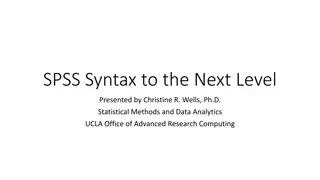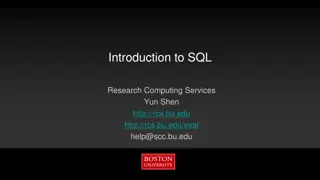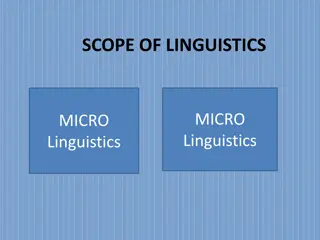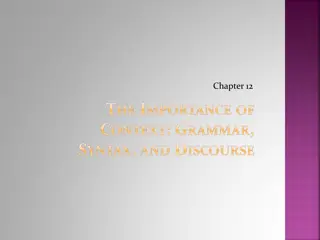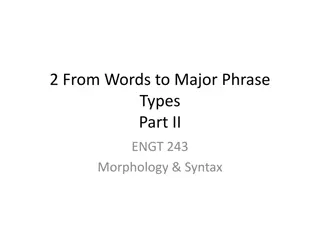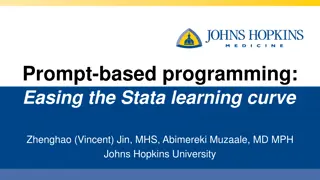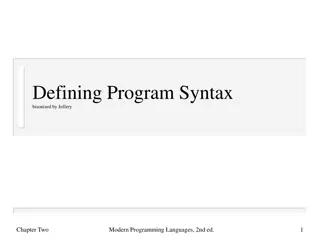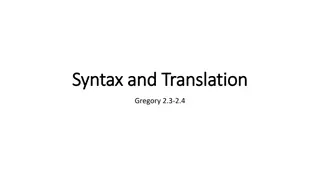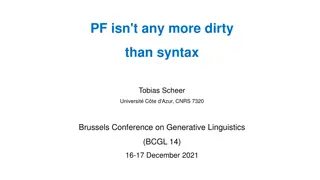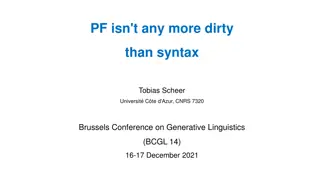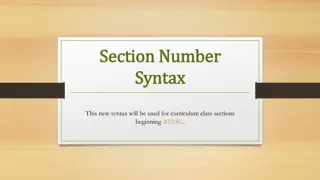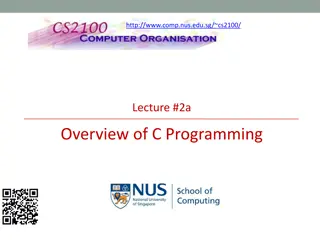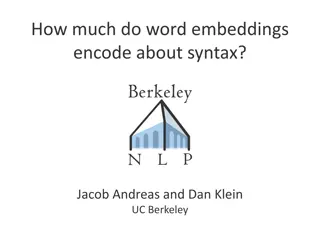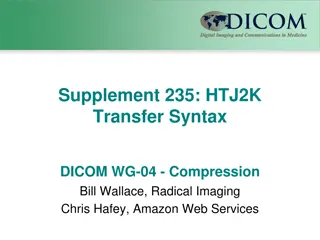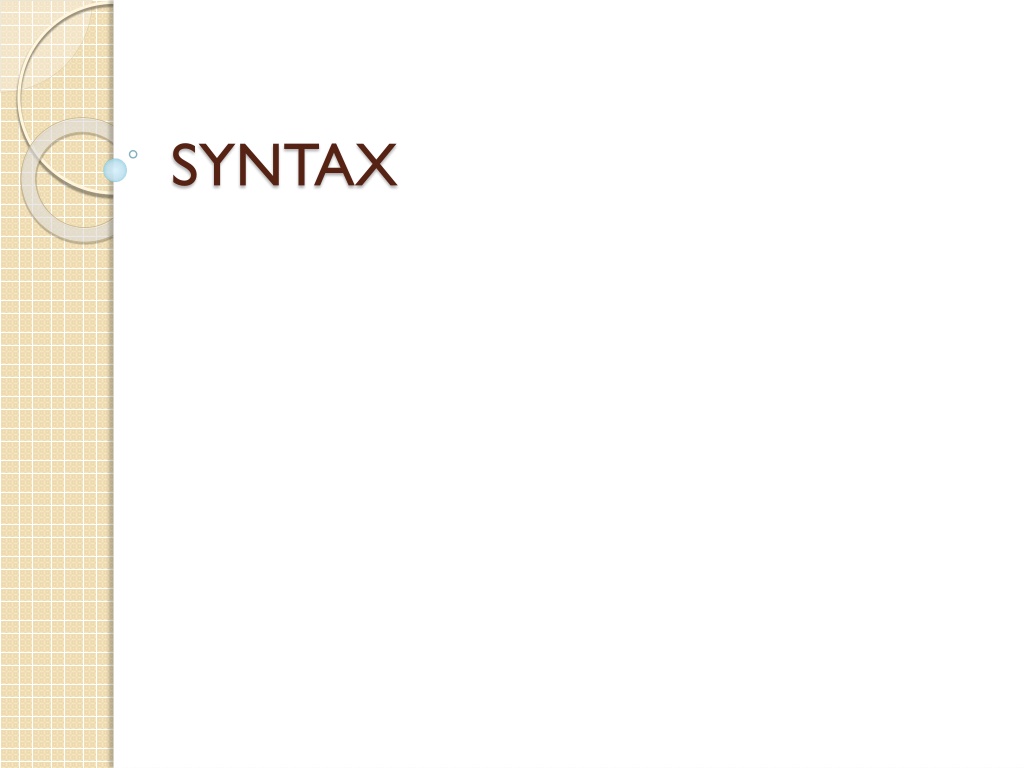
Understanding Syntax in Language Learning
Explore the importance of syntax in language learning through the study of sentence structure, grammar rules, and word combinations. Discover how productivity in language allows for infinite sentence possibilities.
Download Presentation

Please find below an Image/Link to download the presentation.
The content on the website is provided AS IS for your information and personal use only. It may not be sold, licensed, or shared on other websites without obtaining consent from the author. If you encounter any issues during the download, it is possible that the publisher has removed the file from their server.
You are allowed to download the files provided on this website for personal or commercial use, subject to the condition that they are used lawfully. All files are the property of their respective owners.
The content on the website is provided AS IS for your information and personal use only. It may not be sold, licensed, or shared on other websites without obtaining consent from the author.
E N D
Presentation Transcript
The Mobile Phone Manuela is a teacher. She lives in Buenos Aires, Argentina. Last week she was presented with a Teacher of the Year award by the director of her school. The prize was some money and some flowers. Manuela teaches teenagers at a large secondary school and at the weekends she gives private English classes. She is married to a man she met when she was skiing in Bariloche. Bariloche is a famous ski resort inArgentina. Yesterday was Manuela s wedding anniversary. In the morning her husband gave her a beautiful necklace. She was very happy. She cried! She gave him a new mobile phone. He thanked her enthusiastically, even though he had bought himself the same phone the previous day. He wonders he will tell her,but he thinks today is not the right time. Identify : Nouns, Pronouns, Adjective, Verb, Adverbs, Articles, Preposition, Conjunction
Sentence Elements What is Sentence? What is Syntax? Is it important? Why? Part of Speech Vs Lexical Categories Grammaticality Ambiguity Phrase structure
Word Order a) Manuela s / was / wedding anniversary / yesterday b) a / at / Buenos Aires / teenagers / in / large / Manuela / secondary school / teaches c) bus / by / go / I / school / to / usually Put in Punctuation, such as Capital letters, Full stops, questionmark, inverted commas (quotation marks) etc.
Productivity e.g., Laura ate two peanuts. Laura ate three peanuts. Laura ate forty-three million, five hundred and nine peanuts. Laura ate X peanuts. (where X = number)
Productivity We do not store whole sentences, but the words (mental lexicon) and the rules that combine them The set of rules is finite, but the set of possible sentences is not
Syntax The study of the structure of phrases/ sentences and the rules governing how words are combined to form phrases/sentences These rules are acquired at a very young age and internalized.
Grammaticality Sequences of words that conform to the rules of a language are grammatical (well- formed) Grammatical is different from comprehensible
Grammatical or ungrammatical? The cat is on the mat. The mat is on the cat. The cat on is the mat. * * = an ungrammatical or ill-formed sentence Word order is important.
Grammatical or ungrammatical? This sentence no verb. Contains a verb. Sentences need a subject and a verb * * This sentence has cabbage six carrots. *
Grammatical or ungrammatical? Colorless green ideas sleep furiously. Sleep furiously ideas green colorless. * Grammaticality and sense/meaning can be independent of one another. This shows the independence of syntactic rules.
Ambiguity The property of having two or more meanings. Lexical ambiguity Structural ambiguity
Lexical ambiguity Headlines: PROSTITUTES APPEAL TO POPE IRAQI HEAD SEEKS ARMS SOVIET VIRGIN LANDS SHORT OF GOAL AGAIN CHILD S STOOL IS GREAT FOR USE IN GARDEN Lexical ambiguity: when a word has more than one meaning
Structural ambiguity I once shot an elephant in my pajamas. Tonight s program will discuss sex with Dr. Ruth Westheimer. We will not sell gasoline to anyone in a glass container. This mixing bowl is designed to please any cook with a round bottom for efficient beating.
Structural ambiguity Ambiguity resulting from the structure of the phrase or sentence e.g., discuss [sex with Dr. Ruth Westheimer] [discuss sex] [with Dr. Ruth Westheimer] e.g., a large [man s hat] [a large man s] hat
Hierarchy and ambiguity large man s hat (un lock able) (un lock able) large man s hat
Phrase structure 1) Every word belongs to a lexicalcategory 2) Lexical categories forms heads ( main words ) of phrases which can function as a unit 3) How phrases are formed is governed by rules (= phrase structure rules )
Lexical categories Nouns (N): Laura, peanut, house Verbs (V): eat, see, sleep, dive Adjectives (Adj): big, lazy, colorless Determiners (Det): the, a, those, every Prepositions (P): in, of, over, with Adverbs (Adv.): quickly, often A word s lexical category determines what kind of phrasal category it can form
Phrases Built up from lexical categories (their heads) May consist of one or more words They function as a unit These units come together to form sentences
Types of phrases Noun phrase (NP) John the boy a book about a boy a big picture of the boy in a bubble A friend that I ve known for a long time
Types of phrases Verb phrase (VP) fall fell slowly fell (slowly) into the pond buy the book *buy slowly the book buy the book with a credit card
Types of phrases Prepositional phrase (PP): in with a smile of my little teeth between a rock and a hard place at the store by my house


